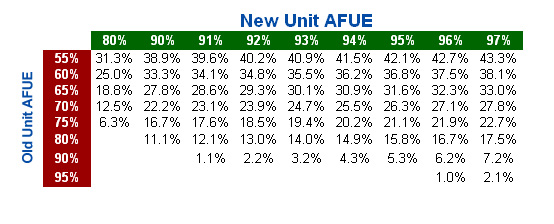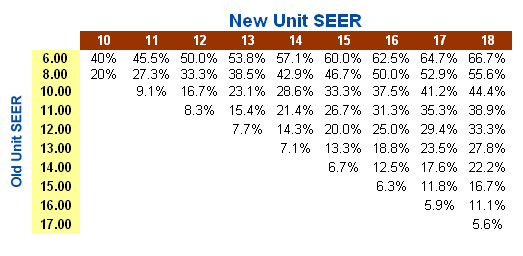Furnace Efficiency
A common reference to a furnace's efficiency rating goes by AFUE (Annual Fuel Utilization Efficiency). In British thermal units (Btu), this equation tells you how efficiently the furnace uses fuel.
In general, the higher the efficiency, the less fuel the furnace will use to heat your home. For every one dollar ($1) you spend on energy, how many cents on the dollar are used to heat the home and how many go up the chimney/flue. This means lower operating costs for you. For example, a furnace may show an intake of 80,000 Btus with an output of 64,000 Btus. Dividing 64,000/80,000 = 80%.
The following table will give you an idea of the approximate savings from installing a more efficient furnace.

In 1992, the government established a minimum AFUE rating of 78% for furnaces installed in homes. In contrast, many furnaces manufactured before 1992 had AFUE ratings as low as 60%. Just like older cars, a furnace works less efficiently as it ages. Just as a car's fuel efficiency diminishes over time, so does a furnaces' working AFUE rating go lower than the initial rating.
Mid-efficiency furnaces, also known as non-condensing or induced draft furnaces, offer efficiencies from 78% to about 80%. High-efficiency furnaces, also called condensing or sealed combustion furnaces, offer AFUE ratings from 90% to about 96.6%.
A rule of thumb to use when shopping for a new furnace: the higher the efficiency, the more expensive the furnace. If you live in a cold climate, you will probably recover the additional cost for a high-efficiency furnace in a few short years, through lower utility bills. There are various ways to calculate a “cost of operation” (C.O.P) to show exactly how much you will save on your monthly heating bill and how long it will take you to recover the additional up front costs. Naturally, after the payback period, you continue to save money on your energy bills for the life of the system.
Several websites sponsored by the federal government can give a greater understanding of ways you might save on your utility bills. The Department of Housing sponsors www.hud.gov and the Department of Energy has www.eere.energy.gov.
Comfort Features
Furnaces with two-speeds can run on low speed and as a result operate more quietly than single-speed furnaces. On lower speeds, a furnace will run on a longer “slow blow” of warm air vs. a “fast blast” that a single-speed furnace produces. This “fast blast” allows for larger temperature swings because of shorter operating periods and more on/off cycles. From a comfort perspective, most people relate this to a house feeling “drafty”. Plus, better air circulation helps prevent your cold feet created by air "stratification" -- warm air rising to the ceiling and cold air settling on the floor. In short, you get consistent, even heat throughout your home.
Variable-capacity furnaces are another step above two-speed models. They provide the ultimate combination of comfort, efficiency and quiet performance. “Smart technology” allows the fan motor to monitor your home's comfort needs and automatically adjust the volume and speed of air to provide the most efficient heating or cooling. They offer added electrical efficiency as well: the "smart" fan motors on today's variable-capacity furnaces use less electricity than a 100-watt light bulb. They operate so efficiently that they can actually increase the efficiency rating of your central air conditioning system. This is because the air conditioner uses the same fan motor to distribute cool air in the summer. It can offer you added energy savings when you use continuous fan operation in any season. SEER (Seasonal Energy Efficiency Ratio) can be increased because of this variable-speed motor.
Air Conditioning Efficiency
For the last number of years, air conditioners have had SEER ratings from 6 to 17: the higher the SEER rating, the more efficient the system. ARI (Air Conditioning and Refrigeration Institute) establishes these ratings based on a set of design conditions.
Starting in 2006, the government will no longer allow the production of any air conditioning systems below 13. We are even starting to see systems that can reach ratings of 20. These ratings can be strongly affected by components that are added to the system. One example is a TXV (thermostatic expansion valve) which more closely monitors the flow of refrigerant through the system.
As a general guideline, the following table can give you an estimate on how much you might be able to save.

|
